Exploring the Pricing Structure of Dubai Metro
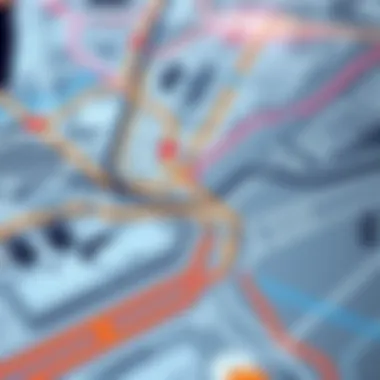

Intro
Navigating Dubai's sprawling landscape can oftentimes feel like untangling a ball of string. While the city is renowned for its skyscrapers and cutting-edge infrastructure, a key element that keeps it moving smoothly is the Dubai Metro. As an integral part of urban transport, the Metro not only connects various districts but does so with a unique pricing structure that warrants a closer look. Understanding the fare options and the factors that shape them can greatly benefit residents, expatriates, and even investors pondering the economic implications of public transport.
In this piece, we will explore the intricacies of Dubai Metro prices, laying out the different fare categories, the elements influencing these prices, and how they stack against alternative modes of transport. We'll also delve into the services provided by the Metro system, all while considering how this affects both daily commuters and occasional visitors. By the end of our journey, readers will have a clearer view of the pricing landscape in the context of Dubai's ever-evolving urban framework.
Understanding Dubai Metro
Understanding the Dubai Metro is crucial for anyone looking to navigate the bustling urban landscape of this city. As a major public transport system, it stands as a testament to Dubai's rapid development and forward-thinking approach to urban mobility. The Metro offers not just a convenient means of travel, but also insights into how the city manages its transport infrastructure to address the needs of residents, tourists, and businesses alike.
Historical Context
The inception of the Dubai Metro can be traced back to the early 2000s when UAE leaders envisioned a modern transport solution to tackle the increasing congestion on the roads. Officially opened in 2009, the system marked a significant leap in public transportation within the region. The ambitious project was not just about providing a means of travel; it represented a commitment to sustainability and innovation. Over the years, its expansion has mirrored Dubai’s growth, accommodating millions of passengers and connecting key areas of the city.
Current Network Overview
Today, the Dubai Metro operates over 75 kilometers of track, making it one of the longest automated metro systems in the world. The network consists of two primary lines—the Red and Green lines—along with multiple stations strategically located to facilitate easy access to major attractions, shopping malls, and business districts. This extensive network allows an average of 500,000 riders per day to seamlessly traverse the city, a remarkable feat considering the varied horizons offered by the urban sprawl.
Operational Hours
The operational hours of the Dubai Metro play a vital role in enhancing the convenience of its services. Typically, the Metro runs from 5 AM until midnight during weekdays, with slightly extended hours on weekends. This schedule accommodates both early morning commuters and night-time travelers, satisfying the diverse needs of a city that never seems to sleep. Moreover, variations in timings on public holidays and special events further demonstrate the flexibility of the system to support the dynamic lifestyle of its users.
In essence, understanding the Dubai Metro not only offers invaluable insights into the city's transport mechanisms but also frames a larger narrative about urban planning and development in one of the world's most vibrant cities.
Fare Structure
Understanding Dubai's Metro fare structure is essential for both residents and visitors looking to navigate the city efficiently. The fare system is designed to be both comprehensive and user-friendly, ensuring that travelers can choose the most economical options for their journeys. A well-structured fare system not only benefits daily commuters but also enhances tourism, making it accessible for everyone who wants to explore the marvels of this vibrant city.
Standard Ticket Prices
The standard ticket prices for the Dubai Metro are based on a distance-based fare system. This means that the longer you travel, the higher your fare will be. This approach promotes fair pricing and encourages the use of public transport for different trip lengths. As of late 2023, the fares typically range from AED 3 for short journeys to about AED 8 for longer trips across multiple fare zones.
For many residents, a journey from the outskirts to the city center can easily fit into their daily budgets, making it a preferred mode of transport. In contrast, for tourists, understanding these pricing dynamics allows them to better plan their sightseeing adventures, ensuring they don’t overspend on transit. Many are surprised to find that a ride can cost less than a bottled water in some cases.
Discounted Tickets
Discounted tickets play a significant role in making the Metro accessible to a wider range of users. Students, seniors, and people with disabilities can avail of reduced fares, underlining Dubai’s commitment to inclusivity. For example, students might find their rides slashed by up to 50%, encouraging them to use public transportation instead of more costly options like taxis.
Additionally, the Metro often runs special promotions or campaigns to boost ridership during certain periods. Keeping an eye on these promotional fares can save a tidy sum for those willing to do just a bit of research before hopping on the train.
Travel Class Options
Travel class options in the Dubai Metro add another layer of convenience and choice for passengers. The Metro consists of two primary classes: Gold Class and Silver Class. Gold Class is marketed towards those who desire a little more luxury, with premium seating and dedicated carriages. This may appeal to business professionals or anyone looking to have a more comfortable ride. The fare for Gold Class is approximately double that of Silver Class, but many consider it worthwhile for the added comfort.
Silver Class, on the other hand, caters to the general public and is ideal for everyday commuters. It provides a no-frills experience, with ample space and reasonable comfort at a lower cost. The choice between these classes illustrates how the Metro accommodates various lifestyles and expectations, making it suitable for all types of travelers.
"Navigating the fare structure not only saves money but enhances the overall travel experience when exploring Dubai."
For up-to-date fare information and promotions, you can check the official RTA website.
Payment Methods
When it comes to navigating the Dubai Metro, understanding the payment methods available is key to a smooth journey. These options cater to a diverse range of riders, from daily commuters to occasional tourists. Having the right method not only streamlines the travel process but also enhances the overall user experience.
Nol Card System
The Nol Card system is the backbone of Dubai's Metro payment landscape. Essentially, it's a smart card that allows you to tap in and out of the Metro stations seamlessly. Here are a few noteworthy points about the Nol Card:
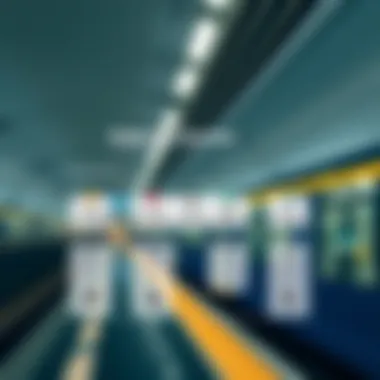
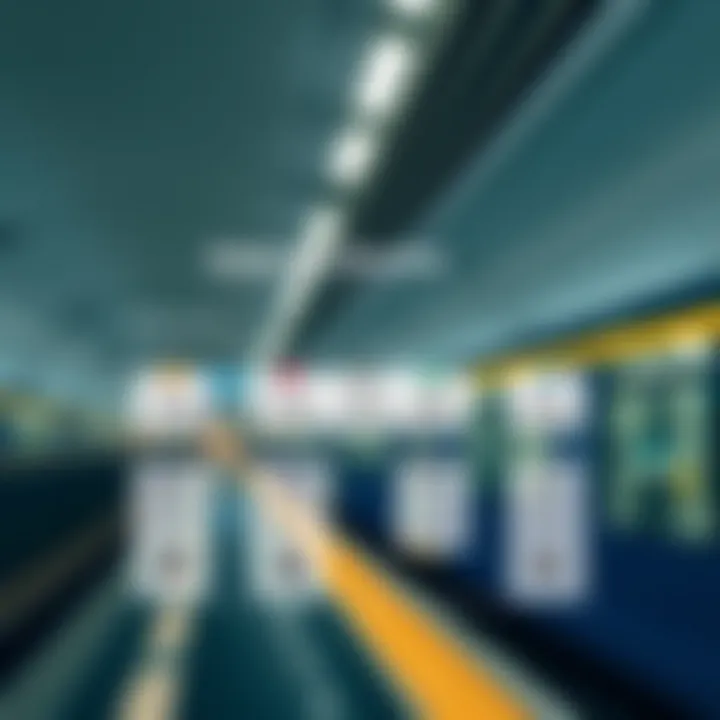
- Various types - From Red, which is meant for tourists and short-term users, to the Blue card for regular commuters, each type serves a distinct purpose.
- Cost Efficiency - Using a Nol Card is generally more economical than buying single tickets. For instance, if you plan to travel multiple times a day, the card can save you some serious dirhams.
- Ease of Use - Topping up is a cinch. You can recharge your card at various kiosks and machines scattered throughout the Metro stations, or even use a mobile app.
Given its wide acceptance not just in the Metro, but also in other public transport systems and even select shops, the Nol Card is invaluable for those looking to traverse the city efficiently.
Single Journey Tickets
For those who prefer to keep things simple, single journey tickets are a suitable option. You purchase a ticket for each trip, which can be ideal for uncertain travel plans. Here’s what to consider:
- Availability - These tickets can be bought at ticket vending machines present in every Metro station.
- Cost - The price of a single journey ticket varies based on the travel zones. The further you travel, the more you pay. This zoning system can sometimes catch newcomers unaware, so it’s wise to be informed ahead of your journey.
- Limitations - Single journey tickets are not reusable and hence, can become more expensive for frequent travelers. Moreover, they can be a hassle for people hopping on and off at different stations throughout the day.
To sum it up, while Nol Cards offer a more convenient and economical means of navigating the Dubai Metro, single journey tickets provide flexibility for those on sporadic journeys. It’s all about what fits best with your travel habits.
Factors Influencing Metro Prices
When we talk about the prices of the Dubai Metro, we need to dig a little deeper into what actually shapes those prices. Understanding the factors that influence metro fares is essential for anyone using this urban transport system, whether it's locals, expatriates, or tourists. There’s more to it than just a flat rate; the pricing structure is quite dynamic, reflecting various elements that make commuting in Dubai a unique experience.
Distance-Based Pricing
The primary aspect that drives the pricing of metro fares is the distance traveled. In straightforward terms, the longer the ride, the more you pay. The pricing structure is divided into zones, and each trip incurs a fare that corresponds to the number of zones crossed during the journey. For instance, traveling from the outskirts of Dubai to the bustling heart of the city, like from Dubai Marina to Burj Khalifa, would naturally cost more than a short hop between neighboring stops.
This approach is particularly beneficial for commuters as it provides a fair way to charge users according to their actual journeys. Distance-based pricing means that those making longer commutes contribute more to the system, promoting usage for quick trips at a lower cost. This setup also enables better allocation of public transport financing, as the funds collected from longer trips can support extended services, new infrastructure, and maintenance efforts.
In addition, it encourages people to plan their routes more effectively. Many commuters use apps or websites to estimate their fare based on distance, ensuring they choose the most economic option on the fly. This distance-based fare approach fits right in line with modern principles of sustainability and efficient resource use.
Peak vs Off-Peak Pricing
Another critical element worth considering is the time of day you choose to ride the metro. In Dubai, much like other bustling cities around the world, peak hours typically see more commuters and, consequently, higher demand for transport services. To manage this variability, Dubai Metro employs a peak and off-peak pricing model.
During peak hours, which often cover early morning and late afternoon commutes, fares may be slightly elevated to reflect the increased use and overcrowding on trains. This strategy not only helps to ease congestion but also encourages travelers with flexible schedules to consider traveling during off-peak hours when prices ring a little quieter. This tactic reduces strain on the system and also keeps the commuting experience more pleasant for everyone involved.
To give a clearer picture, here’s a breakdown of typical peak hours and respective fare changes:
- Peak Hours:
- Off-Peak Hours:
- Morning: 7:00 AM - 9:00 AM
- Evening: 5:00 PM - 7:00 PM
- Adjusted fares may apply.
- Midday: 9:00 AM - 5:00 PM
- Night: 7:00 PM onwards
- Standard fares apply.
By balancing out the pricing structure, the Dubai Metro not only enhances accessibility but also tackles the issue of capacity management head-on. This way, both short-term and long-term strategies work in tandem—making for a smoother ride, regardless of when you choose to travel.
Effective pricing is about understanding rider behavior—it’s both art and science.
Navigating the fare structure of the Dubai Metro is much simpler when comprehending the underlying factors that influence pricing. With distance-based pricing ensuring equity among commuters and peak vs off-peak strategies optimizing usage patterns, it becomes clear that Dubai’s metro fare system is not a mere afterthought but a thoughtfully engineered approach to urban mobility.
Comparative Analysis
When assessing the transportation landscape in Dubai, conducting a comparative analysis offers clarity and depth to the discussion. It's not just about choosing a mode of transport; it's about understanding the benefits, costs, and convenience of each option available. Such comparisons can enlighten potential users—be they residents or visitors—on how best to navigate the vibrant city using its network of transport options. This section dives into the specifics of three primary forms of ground transportation: the Dubai Metro, taxi services, ride-sharing options, and buses.
Metro vs. Taxi Services
In many global cities, taxis have long been considered the quintessential choice for on-demand transportation. In Dubai, however, comparing taxi services to the Metro reveals some significant differences in cost and convenience.
- Pricing: A typical taxi fare in Dubai starts at around 12 AED, which translates to roughly three dollars, with additional costs per kilometer. In contrast, a metro ticket can range from just 3 AED to 8 AED based on the travel distance. Depending on the point of departure and destination, commuters can find that the Metro provides a more economical way to travel, particularly for longer distances.
- Accessibility: While taxis can be hailed from virtually any street corner, the Metro stations tend to be strategically located near major attractions and business hubs. However, one has to consider the proximity of stations when planning an itinerary.
- Travel Time: The Metro operates its services efficiently, with trains arriving at intervals of seven to ten minutes. However, traffic congestion can substantially extend travel times when using a taxi. During peak hours, commuters may find themselves stuck on the busy roads, while the Metro glides at a steady pace above the fray.
The metro is often the fastest way to traverse the city, especially during rush hours.
Metro vs. Ride-Sharing Services
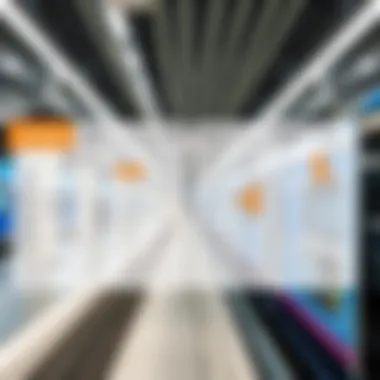
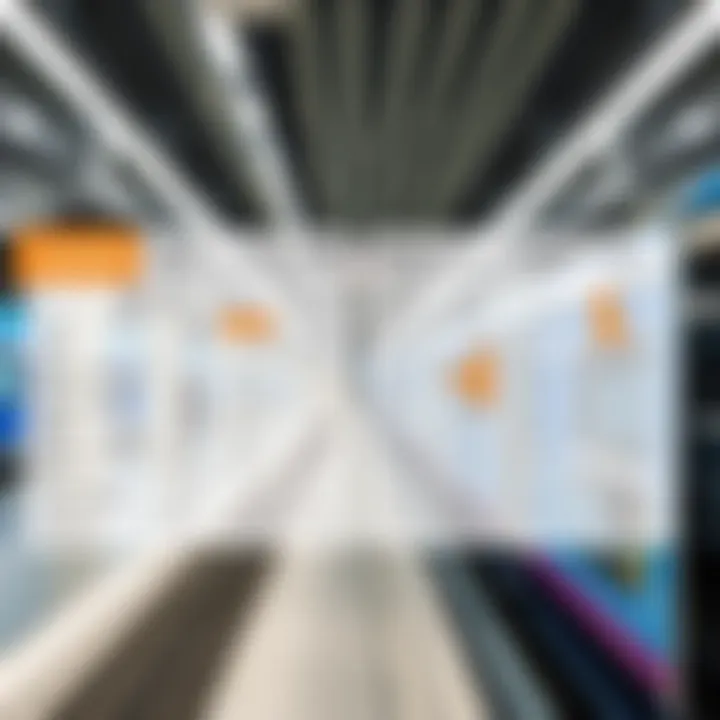
In recent years, ride-sharing apps like Uber and Careem have carved out a significant niche in Dubai's transport ecosystem. When comparing these services with the Metro, some interesting points arise.
- Cost Implications: Ride-sharing fares can fluctuate wildly, especially during peak times or busy events, leading to what is commonly referred to as ‘surge pricing’. This can make ride-sharing more expensive than using the Metro, especially for regular commutes. Basic fares might start at around 10 AED, but the final amount can stack up when additional charges kick in.
- Comfort and Convenience: For many, the charm of ride-sharing lies in door-to-door service. One can simply summon a car and enjoy a ride in relative comfort. In contrast, the Metro requires more planning regarding walk time to stations and potential transfers between lines. For those traveling with heavy luggage or during extreme weather, ride-sharing might come out ahead.
- Environmental Impact: Another aspect worth considering is the carbon footprint. Mass transit options like the Metro generally have a lower impact in terms of emissions compared to multiple individual ride-share cars clogging up the roads, promoting a cleaner mode of transport.
Metro vs. Buses
Finally, let’s explore how the Metro stacks up against Dubai's bus network. Buses offer a different array of options that can serve as a complementary transport choice to the Metro.
- Ticket Pricing: Bus fares are generally in line with Metro prices, but they depend heavily on the distance. A typical trip can cost around 3 AED, making it relatively inexpensive as well. Still, the Metro's efficiency stands out for longer travels.
- Frequency and Coverage: Dubai’s bus system is extensive, providing access to many areas that the Metro might not touch. However, buses can run a bit less frequently, especially on less popular routes. The metro, especially during rush hour, may provide a more reliable timetable.
- Overall Experience: Traveling by bus can sometimes offer a unique glimpse of local life, as one may encounter residents from different walks of life. Conversely, the Metro is designed for speed and convenience, making it a wiser choice for those keen on getting to their destination in the least amount of time.
By analyzing these transportation options, it becomes evident that each mode has its set of strengths and weaknesses. Understanding these nuances helps commuters choose wisely based on their needs and situational demands.
Impact on Urban Mobility
The Dubai Metro serves as a backbone for the urban mobility landscape in the emirate. It is more than just a transportation system; it is a vital artery that connects diverse regions, facilitates economic activities, and enhances the quality of life for its users. Understanding the impact of the metro on urban mobility is crucial for multiple stakeholders including investors, expatriates, and urban planners. This section will explore two key aspects of the metro's role in urban mobility – connecting Dubai's areas and alleviating traffic congestion.
Connecting Dubai’s Areas
The intricate web of the Dubai Metro encompasses various neighborhoods, commercial hubs and recreational zones, providing seamless connections that many residents now rely on. A prime example is the extension to the Expo 2020 site, which not only boosts accessibility for visitors and locals alike but also showcases Dubai’s commitment to efficient public transport solutions. This access translates to a greater footfall for businesses, positively influencing local economies.
Moreover, the connectivity offered by the metro encourages a more pedestrian-friendly environment in areas surrounding station stops. With well-planned routes and strategic station placements, the metro facilitates easy transfers to other modes of transportation, such as buses and taxis. Not only does this openness improve mobility, it also stimulates social interactions among people from various walks of life. To put it simply, the Dubai Metro has turned what was once a sprawling, car-dependent cultural landscape into a more interconnected and cohesive society.
Alleviating Traffic Congestion
Traffic congestion in urban settings is a common woe, especially in a bustling metropolis like Dubai. The introduction of the metro has been nothing short of a relief valve for the city’s roadways. By providing an alternative mode of transport, it has significantly reduced the number of vehicles on the roads. A study from the Roads and Transport Authority shows that the metro has eliminated thousands of trips daily, easing the crunch during peak hours.
Furthermore, as the population continues to rise, so does the number of daily commuters. Without effective public transport solutions, the city would face gridlock, jeopardizing economic productivity and residents’ quality of life. The metro has played a vital role in mitigating these adverse effects. It has catalyzed a shift in commuting habits, with more people choosing train travel over personal vehicles, thereby contributing to reduced carbon emissions.
"The Dubai Metro is a game changer in urban transport, bringing that small-town feel to a bustling city," says urban analyst Sarah Al-Habsi, highlighting how public transit systems can transform city life.
In summary, the impact of the Dubai Metro on urban mobility is profound. By connecting various areas and alleviating traffic congestion, it not only enhances the daily commutes of Dubai’s residents but also supports the city’s economic and social vibrancy. With the anticipated expansions, it continues to promise an even more interconnected future.
Regular Commuters and Price Strategies
Understanding the pricing strategies aimed at regular commuters is vital for comprehending the overall function and accessibility of the Dubai Metro system. This segment delves into the financial implications for those who rely on the Metro daily, highlighting their options and the overall benefits such pricing schemes offer.
Monthly Pass Options
For regular commuters, the monthly pass options provide not just convenience but also substantial savings. As many individuals use the Metro for the bulk of their daily transport needs, these passes can dramatically lessen their overall costs.
Consider, for instance, the monthly pass priced at AED 300, which allows unlimited travel across all zones. In comparison, purchasing single journey tickets daily can rack up much higher expenses. For regular users, a month-end tally of their one-off trips can reveal a significant spike in their transport spending, making the monthly pass a wise choice.
Moreover, monthly passes cater to various commuter profiles, targeting tourists who may need more flexibly priced travel options, offering both short-term and longer-term benefits.
- Types of Monthly Passes Available:
- Gold Class Monthly Pass: Offers access to the Gold Class cabins, a more private and premium experience.
- Silver Class Monthly Pass: Standard fare for regular commuters, ensuring access to all parts of Dubai Metro without premium costs.
It’s not just the pricing that makes these options appealing; they also reduce the hassle of purchasing tickets each day. Commuters can simply tap their Nol cards and get on with their journeys.
Long-Term Economic Considerations
When discussing long-term economic considerations, it’s crucial to consider how the pricing strategies for the Metro have broader implications for both the commuter and the city's economy overall. Regular commuters play a pivotal role in the vibrancy of Dubai's urban landscape, directly affecting economic and environmental sustainability.
From an economic standpoint, frequent use of public transport aids in better traffic management by reducing congestion on roads. When more people opt for the Metro, less wear and tear happens on surface transport systems, indirectly prolonging their lifespan and decreasing maintenance costs.
In addition, the convenience that Metro offers can encourage more businesses to develop in areas around stations. Such developments result in a positive feedback loop where increasing footfall boosts local economies, and ultimately creates a more interconnected urban ecosystem. Businesses benefit, too, as they attract a steady stream of customers using the Metro.
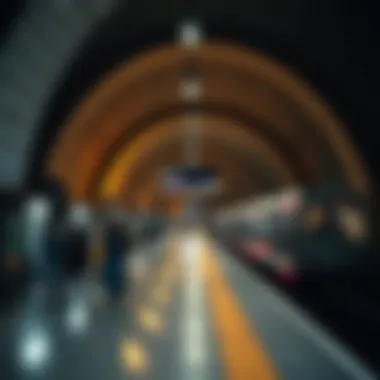

- Things to consider for economic viability:
- Regular commuter discounts can stimulate increased usage, ensuring steady fare revenue.
- Understanding the relationship between Metro mobility options and commercial growth can help city planners.
- Monitoring commuter patterns can inform future price adjustments to keep pace with usage trends.
In summary, the economic considerations surrounding regular commuters and their expenses reveal a deeper connection between public transport use and urban flourishing. The monthly passes not only offer practical fiscal advantages for the individual but also contribute significantly to the positive development of Dubai's infrastructure and local businesses.
Visitor Considerations
When it comes to navigating a bustling metropolis like Dubai, understanding the visitor considerations related to its Metro system can significantly enhance the experience. For tourists and occasional travelers alike, knowing the ins and outs of the Metro prices and services not only eases the journey but also creates a seamless travel experience. Visitors can immerse themselves in the city's thriving environment while effectively managing transportation costs.
Tourist Tickets
For first-time visitors to Dubai, the Dubai Metro offers specially designed tourist tickets that ensure easy and economical travel throughout the city. These tickets are advantageous as they provide visitors with access to the Metro network without the need to purchase multiple single journey tickets. One such option is the Tourist Day Pass, which allows unlimited travel for 24 hours, making it an attractive choice for those intent on exploring various attractions without worrying about fare calculations.
Additionally, tourists can opt for a Red Nol Card specifically tailored for visitors. This card can be loaded with multiple fare options and is usable on all public transport systems in Dubai, including buses. It is noteworthy that these tourist tickets often come at a discounted rate as compared to regular fares, allowing travelers to save some dirhams for souks or dining experiences.
Navigating the Metro as a Visitor
Understanding how to navigate the Dubai Metro system is pivotal for maximizing a visitor’s time and budget. The Metro runs from Rashidiya in the east to UAE Exchange in the west, serving a multitude of attractions along its route, such as the Burj Khalifa and Dubai Marina. Visitors can easily plan their journey by utilizing the RTA Dubai app, where they can find real-time information on train schedules and stops.
Signs in English and Arabic throughout the stations make navigation straightforward for foreign travelers. Additionally, station information includes maps that signify important landmarks and connections to other transport modes.
A key consideration is to be aware of the designated carriage rules that allow for women and children in specific carriages, offering a degree of comfort and security. Furthermore, ensuring one has sufficient credit on their Nol card or ticket will help avoid any last-minute hassles.
"The Dubai Metro is a marvel of modern engineering, making commuting not just convenient but also a part of the whole Dubai experience."
For more detailed transit information, you can always refer to the RTA Dubai website. Plan your trip wisely and enjoy all that Dubai has to offer!
Future of Dubai Metro Pricing
As the urban landscape in Dubai continues its rapid transformation, the future of Metro pricing remains a pivotal topic. With more expatriates and visitors flocking to this city, understanding the anticipated shifts in fare structure is crucial for both the local population and investors. The subsequent sections aim to elucidate upcoming changes while also digging into sustainability practices that may shape pricing strategies.
Anticipated Changes
In light of Dubai's ambitious expansion plans, the Metro is set to evolve alongside the city's growth. Notably, the introduction of new routes is foreseen to broaden accessibility significantly. As more areas become connected via the Metro system, it is highly likely this will influence fare adjustments. While specifics on pricing revisions remain speculative, the anticipation of additional stations suggests that current ticket pricing could be recalibrated based on distance traveled.
Another aspect to consider is how regulatory changes, such as increased fuel prices or shifts in governmental transport policies, might necessitate fare increments. Conversely, to encourage usage among tourists and residents, we might observe incentives or promotions tied to certain times of the year. This could be beneficial for regular commuters who rely on the Metro as part and parcel of daily travel. In sum, prospective alterations in pricing will reflect a dynamic interplay of operational considerations and expanding service offerings.
Sustainability and Pricing
In today’s eco-conscious climate, sustainability plays a critical role in the municipal transport models across the globe, and Dubai is no exception. The integration of sustainable practices within the pricing framework of the Metro service is set to become a focal point for improvement.
- Green Initiatives: The Metro has made strides in operating on renewable energy sources. As enhancements in infrastructure occur, it's plausible that investments in greener technologies might shift costs. Some costs may be passed down to the consumers, while other expenses could be absorbed by the government.
- Fleet Expansion: Growth in the fleet that includes environmentally friendly vehicles might also push the boundaries of fare adjustments. If the government opts for electric or hybrid trains, the upfront investment could be significant. However, the long-term savings on energy could theoretically serve to stabilize or even reduce prices over time.
- Public Awareness Campaigns: Stakeholders might introduce programs promoting sustainable transport choices, such as subsidized fares for using public transit over vehicles. This would emphasize the role of the Metro in reducing carbon footprints, resonating positively with the eco-conscious demographic of Dubai.
Ultimately, the alignment of sustainability with price setting is expected to yield not just conducive environmental impacts but also promote a culture of responsible transport choices. This approach would cater to a growing desire among residents and visitors to balance convenience with ecological responsibility. In relocating the future of Dubai Metro pricing, stakeholders must take heed of these emerging narratives, aligning operational strategies with environmental policies while keeping an eye on consumer satisfaction.
Epilogue
The conclusion of our exploration into the pricing structure of the Dubai Metro encapsulates the myriad elements we have discussed. Understanding the pricing schemes is crucial for grasping the full extent of what the Dubai Metro offers.
From fare tiers to payment methods, the insights gathered help regular commuters, occasional travelers, and even visitors. It aids in planning and budgeting for transport in a city that is renowned for its rapid development and expansive infrastructure.
Specific elements of this discussion include:
- Fare Structure: Knowing the fare options can significantly ease commute planning and expectation for daily users.
- Payment Methods: A thorough knowledge of payment options provides flexibility, allowing travelers to choose what suits their needs best.
- Impact on Urban Mobility: The Metro’s pricing structure directly relates to its contribution to reducing congestion, promoting public transport use, and, thereby, enhancing overall urban mobility.
Benefits of comprehending the price structuring include:
- Increased efficiency in utilizing public transport rather than private vehicles, thus saving time and reducing carbon footprints.
- Encouragement of tourist footfall through the clarity of ticketing options, enhancing Dubai’s attractiveness as a global destination.
- Informed decision-making for investors considering transportation and infrastructure sectors.
If you ponder over the long-term implications, the pricing strategies reveal an intention to balance affordability with high-quality services. The sustainability aspect is also vital as it aligns with global trends towards greener transport options. An informed perspective will foster economic growth, sustainable transport, and a better quality of life for residents and visitors alike.
In essence, the analysis presented here is not purely academic; it’s a practical guide that can empower various stakeholders, including investors, agents, expatriates, analysts, and buyers. Understanding the fare ecosystem transforms a user’s experience from mundane to enlightened, illustrating how an effective metro system is not merely a means of transportation but a lifeline for a bustling metropolis like Dubai.



